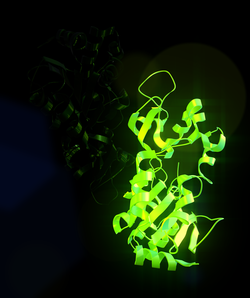Sirtuin 1, also known as NAD-dependent deacetylase sirtuin-1, is a protein that in humans is encoded by the SIRT1 gene.[5][6][7]
SIRT1 stands for sirtuin (silent mating type information regulation 2 homolog) 1 (S. cerevisiae), referring to the fact that its sirtuin homolog (biological equivalent across species) in yeast (Saccharomyces cerevisiae) is Sir2. SIRT1 is an enzyme located primarily in the cell nucleus that deacetylates transcription factors that contribute to cellular regulation (reaction to stressors, longevity).[8][9]
- ^ a b c GRCh38: Ensembl release 89: ENSG00000096717 – Ensembl, May 2017
- ^ a b c GRCm38: Ensembl release 89: ENSMUSG00000020063 – Ensembl, May 2017
- ^ "Human PubMed Reference:". National Center for Biotechnology Information, U.S. National Library of Medicine.
- ^ "Mouse PubMed Reference:". National Center for Biotechnology Information, U.S. National Library of Medicine.
- ^ Frye RA (June 1999). "Characterization of five human cDNAs with homology to the yeast SIR2 gene: Sir2-like proteins (sirtuins) metabolize NAD and may have protein ADP-ribosyltransferase activity". Biochemical and Biophysical Research Communications. 260 (1): 273–79. doi:10.1006/bbrc.1999.0897. PMID 10381378.
- ^ "Entrez Gene: SIRT1 sirtuin (silent mating type information regulation 2 homolog) 1 (S. cerevisiae)".
- ^ SIRT1 human gene location in the UCSC Genome Browser.
- ^ Sinclair DA, Guarente L (March 2006). "Unlocking the Secrets of Longevity Genes". Scientific American. 294 (3): 48–51, 54–7. Bibcode:2006SciAm.294c..48S. doi:10.1038/scientificamerican0306-48. PMID 16502611.
- ^ Fujita Y, Yamashita T (2018). "Sirtuins in Neuroendocrine Regulation and Neurological Diseases". Frontiers in Neuroscience. 12: 778. doi:10.3389/fnins.2018.00778. PMC 6213750. PMID 30416425.





